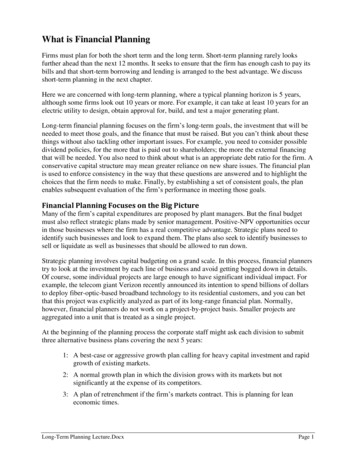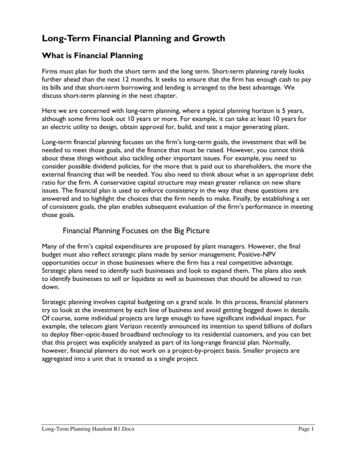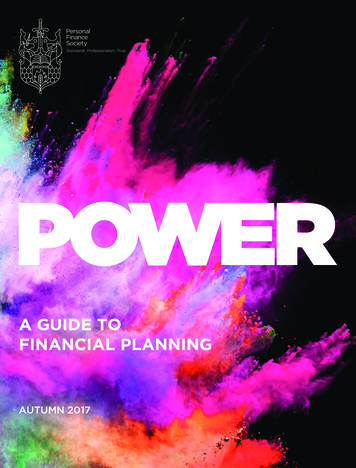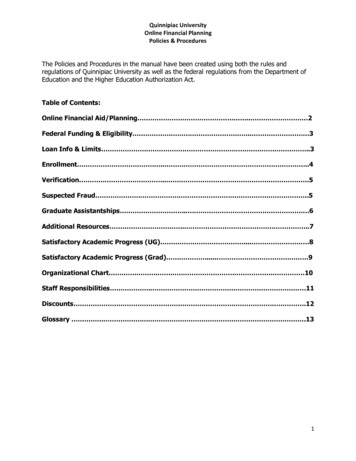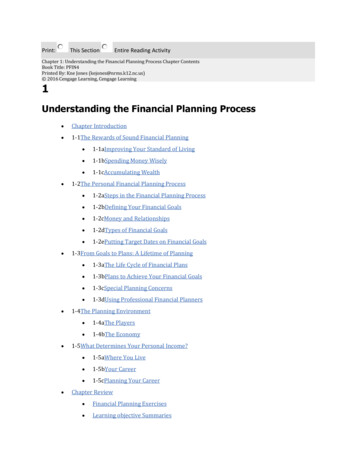
Transcription
Print:This SectionEntire Reading ActivityChapter 1: Understanding the Financial Planning Process Chapter ContentsBook Title: PFIN4Printed By: Kne Jones (kejones@nrms.k12.nc.us) 2016 Cengage Learning, Cengage Learning1Understanding the Financial Planning Process Chapter Introduction 1-1The Rewards of Sound Financial Planning 1-1aImproving Your Standard of Living 1-1bSpending Money Wisely 1-1cAccumulating Wealth1-2The Personal Financial Planning Process 1-2aSteps in the Financial Planning Process 1-2bDefining Your Financial Goals 1-2cMoney and Relationships 1-2dTypes of Financial Goals 1-2ePutting Target Dates on Financial Goals1-3From Goals to Plans: A Lifetime of Planning 1-3aThe Life Cycle of Financial Plans 1-3bPlans to Achieve Your Financial Goals 1-3cSpecial Planning Concerns 1-3dUsing Professional Financial Planners1-4The Planning Environment 1-4aThe Players 1-4bThe Economy1-5What Determines Your Personal Income? 1-5aWhere You Live 1-5bYour Career 1-5cPlanning Your CareerChapter Review Financial Planning Exercises Learning objective Summaries
Key TermsChapter 1: Understanding the Financial Planning Process Chapter IntroductionBook Title: PFIN4Printed By: Kne Jones (kejones@nrms.k12.nc.us) 2016 Cengage Learning, Cengage LearningChapter Introduction wavebreakmedia ltd/ Shutterstock.comLearning ObjectivesAfter studying this chapter, you will be able to LO1Identify the benefits of using personal financial planning techniques to manage yourfinances. LO2Describe the personal financial planning process and define your goals. LO3Explain the life cycle of financial plans, the role they play in achieving your financialgoals, how to deal with special planning concerns, and the use of professional financialplanners. LO4Examine the economic environment’s influence on personal financial planning. LO5Evaluate the impact of age, education, and geographic location on personal income.
LO6Understand the importance of career choices and their relationship to personalfinancial planning.How Will This Affect Me?The heart of financial planning is making sure your values line up with how you spend and save. Thatmeans knowing where you are financially and planning on how to get where you want to be in the futureno matter what life throws at you. For example, how should your plan handle the projection that SocialSecurity costs may exceed revenues by 2033? And what if the government decides to raise marginal taxrates to help cover the federal deficit? An informed financial plan should reflect such uncertainties andmore.This chapter reviews the financial planning process and explains its context. Topics include howfinancial plans change to accommodate your current stage in life and the role that financial planners canplay in helping you achieve your objectives. After reading this chapter you will have a good perspectiveon how to organize your overall personal financial plan.Chapter 1: Understanding the Financial Planning Process: 1-1 The Rewards of Sound Financial PlanningBook Title: PFIN4Printed By: Kne Jones (kejones@nrms.k12.nc.us) 2016 Cengage Learning, Cengage Learning1-1 The Rewards of Sound Financial PlanningLO1Identify the benefits of using personal financial planning techniques to manage your finances.What does living “the good life” mean to you? Does it mean having the flexibility to pursue your dreamsand goals in life? Is it owning a home in a certain part of town, starting a company, being debt free,driving a particular type of car, taking luxury vacations, or having a large investment portfolio? Today’scomplex, fast-paced world offers a bewildering array of choices. Rapidly changing economic, political,technological, and social environments make it increasingly difficult to develop solid financial strategiesthat will improve your lifestyle consistently. Moreover, the recent financial crisis dramatizes the need toplan for financial contingencies. No matter how you define it, the good life requires sound planning toturn financial goals into reality.The best way to achieve financial objectives is through personal financial planning, which helps defineyour financial goals and develop appropriate strategies to reach them. We should not solely depend onemployee or government benefits—such as steady salary increases or adequate funding from employerpaid pensions or Social Security—to retire comfortably. Creating flexible plans and regularly revisingthem is the key to building a sound financial future. Successful financial planning also brings rewardsthat include greater flexibility, an improved standard of living, wise spending habits, and increasedwealth. Of course, planning alone does not guarantee success; but having an effective, consistent plancan help you use your resources wisely. Careful financial planning increases the chance that your
financial goals will be achieved and that you will have sufficient flexibility to handle such contingenciesas illness, job loss, and even financial crises.The goal of this book is to remove the mystery from the personal financial planning process and replaceit with the tools you need to take charge of your personal finances and your life. To organize thisprocess, the text is divided into six parts as follows. Part 1: Foundations of Financial Planning Part 2: Managing Basic Assets Part 3: Managing Credit Part 4: Managing Insurance Needs Part 5: Managing Investments Part 6: Retirement and Estate PlanningEach part explains a different aspect of personal financial planning, as shown in Exhibit 1.1. Thisorganizational scheme revolves around financial decision making that’s firmly based on an operationalset of financial plans. We believe that sound financial planning enables individuals to make decisionsthat will yield their desired results.Exhibit 1.1Organizational Planning ModelThis text emphasizes making financial decisions regarding assets, credit, insurance,investments, and retirement and estates. Cengage Learning Chapter 1: Understanding the Financial Planning Process: 1-1a Improving Your Standard of LivingBook Title: PFIN4Printed By: Kne Jones (kejones@nrms.k12.nc.us) 2016 Cengage Learning, Cengage Learning1-1a Improving Your Standard of Living
With personal financial planning we learn to acquire, use, and control our financial resources moreefficiently. It allows us to gain more enjoyment from our income and thus to improve our standard oflivingthe necessities, comforts, and luxuries enjoyed or desired by an individual or family—thenecessities, comforts, and luxuries we have or desire.Americans view standards of living, and what constitute necessities or luxuries, differently depending ontheir level of affluence. For example, 45 percent of Americans consider a second or vacation home theultimate symbol of affluence, while others see taking two or more annual vacations or living in anexclusive neighborhood as an indicator of wealth.So our quality of life is closely tied to our standard of living. Although other factors—geographiclocation, public facilities, local cost of living, pollution, traffic, and population density—also affect qualityof life, wealth is commonly viewed as a key determinant. Material items such as a house, car, andclothing as well as money available for health care, education, art, music, travel, and entertainment allcontribute to our quality of life. Of course, many so-called wealthy people live “plain” lives, choosing tosave, invest, or support philanthropic organizations with their money rather than indulge themselveswith luxuries.One trend with a profound effect on our standard of living is the two-income family. What was relativelyrare in the early 1970s has become commonplace today, and the incomes of millions of families haverisen sharply as a result. About 75 percent of married adults say that they and their mate share all theirmoney, while some partners admit to having a secret stash of cash. Two incomes buy more, but they alsorequire greater responsibility to manage the money wisely.Chapter 1: Understanding the Financial Planning Process: 1-1b Spending Money WiselyBook Title: PFIN4Printed By: Kne Jones (kejones@nrms.k12.nc.us) 2016 Cengage Learning, Cengage Learning1-1b Spending Money WiselyUsing money wisely is a major benefit of financial planning. Whatever your income, you can either spendit now or save some of it for the future. Determining your current and future spending patterns is animportant part of personal money management. The goal, of course, is to spend your money so that youget the most satisfaction from each dollar.Current NeedsYour current spending level is based on the necessities of life and your average propensity toconsumethe percentage of each dollar of income, on average, that a person spends for current needsrather than savings, which is the percentage of each dollar of income, on average, that is spent forcurrent needs rather than savings. A minimum level of spending would allow you to obtain only the
necessities of life: food, clothing, and shelter. Although the quantity and type of food, clothing, andshelter purchased may differ among individuals depending on their wealth, we all need these items tosurvive.Some people with high average propensities to consume earn low incomes and spend a large portion ofit on basic necessities. On the other hand, individuals earning large amounts quite often have lowaverage propensities to consume, in part because the cost of necessities represents only a small portionof their income.Still, two people with significantly different incomes could have the same average propensity toconsume because of differences in their standard of living. The person making more money may believeit is essential to buy better-quality items or more items and will thus, on average, spend the samepercentage of each dollar of income as the person making far less.Future NeedsA carefully developed financial plan should set aside a portion of current income for deferred, futurespending. Placing these funds in various savings and investment vehicles allows you to generate a returnon your funds until you need them. For example, you may want to build up a retirement fund tomaintain a desirable standard of living in your later years. Instead of spending the money now, you deferactual spending until the future when you retire. Nearly 35 percent of Americans say retirementplanning is their most pressing financial concern. Other examples of deferred spending include savingfor a child’s education, a primary residence or vacation home, a major acquisition (such as a car or homeentertainment center), or even a vacation.Be Smart in Planning Your Financial GoalsSuccess is most likely if your goals are:Specific: What do I want to achieve? What is required of me, and what are my constraints?Measurable: How much money is needed? How will I know if I am succeeding?Attainable: How can I do this? Is this consistent with my other financial goals?Realistic: Am I willing and able to do this?Timely: What is my target date? What short-term goals must be achieved along the way to achieve mylonger-term goals?Inspired by Paul J. Meyer’s, Attitude Is Everything, The Meyer Resource Group, 2003.
The portion of current income we commit to future needs depends on how much we earn and also onour average propensity to consume. Many affluent Americans say they need at least 5 million to feelrich. And more generally, most people say that it would take about twice their current net worth to feelwealthy. The more we earn and the less we devote to current spending, the more we can commit tomeeting future needs. In any case, some portion of current income should be set aside regularly forfuture use. This practice creates good saving habits.Chapter 1: Understanding the Financial Planning Process: 1-1c Accumulating WealthBook Title: PFIN4Printed By: Kne Jones (kejones@nrms.k12.nc.us) 2016 Cengage Learning, Cengage Learning1-1c Accumulating WealthIn addition to using current income to pay for everyday living expenses, we often spend it to acquireassets such as cars, a home, or stocks and bonds. Our assets largely determine how wealthy we are.Personal financial planning plays a critical role in the accumulation of wealth by directing our financialresources to the most productive areas.One’s wealththe total value of all items owned by an individual, such as savings accounts, stocks, bonds,home, and automobilesis the net total value of all the items that the individual owns. Wealth consists offinancial and tangible assets. Financial assetsintangible assets, such as savings accounts and securities,that are acquired for some promised future returnare intangible, paper assets, such as savings accountsand securities (stocks, bonds, mutual funds, and so forth). They are earning assets that are held for thereturns they promise. Tangible assetsphysical assets, such as real estate and automobiles, that can beheld for either consumption or investment purposes, in contrast, are physical assets, such as real estateand automobiles. These assets can be held for either consumption (e.g., your home, car, artwork, orjewelry) or investment purposes (e.g., a duplex purchased for rental income). In general, the goal ofmost people is to accumulate as much wealth as possible while maintaining current consumption at alevel that provides the desired standard of living. To see how you compare with the typical American infinancial terms, check out the statistics in Exhibit 1.2.Exhibit 1.2The Average American, Financially SpeakingThis financial snapshot of the “average American” gives you an idea of where you stand in terms ofincome, net worth, and other measures. It should help you set some goals for the future.
Income and AssetsWhat Do We Earn? (median)All families 45,800What Are We Worth? (median)All families 77,300Home Ownership (median)Value of primary residenceMortgage on primary residence 170,000109,000How Much Savings Do We Have? (median)Pooled investment funds (excluding money market) 58,700Stocks17,800Bonds83,800Bank accounts/CDs25,200Retirement accounts47,100Source: Adapted from Jesse Bricker, Arthur B. Kennickell, Kevin B. Moore, and John Sabelhaus, “Changes in U.S. FamilyFinances from 2007 to 2010: Evidence from the Survey of Consumer Finances,” Federal Reserve Bulletin, June 2012,Volume 98, Number 2, Tables 1, 4, 6, 9, and 13, Board of Governors of the Federal Reserve System, Washington,DC, http://federalreserve.gov/econresdata/scf/scf 2010.htm, accessed July 2014.Chapter 1: Understanding the Financial Planning Process: 1-2 The Personal Financial Planning ProcessBook Title: PFIN4Printed By: Kne Jones (kejones@nrms.k12.nc.us) 2016 Cengage Learning, Cengage Learning
1-2 The Personal Financial Planning ProcessLO2Describe the personal financial planning process and define your goals.Many people mistakenly assume that personal financial planning is only for the wealthy. However,nothing could be further from the truth. Whether you have a lot of money or not enough, you still needpersonal financial planning. If you have enough money, planning can help you spend and invest it wisely.If your income seems inadequate, taking steps to plan your financial activities will lead to an improvedlifestyle. Personal financial planninga systematic process that considers important elements of anindividual’s financial affairs in order to fulfill financial goalsis a systematic process that considers theimportant elements of an individual’s financial affairs and is aimed at fulfilling his or her financial goals.Everyone—including recent college graduates, young married couples, and others—needs to develop apersonal financial plan.Everyone—including recent college graduates, young married couples, and others—needs to develop apersonal financial plan. Knowing what you need to accomplish financially, and how you intend to doit, gives you an edge over someone who merely reacts to financial events as they unfold. Just think of theexample provided by the recent financial crisis. Do you think that a financial plan would have helped inweathering the financial storm?Chapter 1: Understanding the Financial Planning Process: 1-2a Steps in the Financial Planning ProcessBook Title: PFIN4Printed By: Kne Jones (kejones@nrms.k12.nc.us) 2016 Cengage Learning, Cengage Learning1-2a Steps in the Financial Planning ProcessIf you take a closer look at financial planning, you’ll see that the process translates personal financialgoals into specific financial plans, which then help you implement those goals through financialstrategies. The financial planning process involves the six steps shown inExhibit 1.3. As you can see, thefinancial planning process runs full circle. You start with financial goals, formulate and implementfinancial plans and strategies to reach them, monitor and control progress toward goals throughbudgets, and use financial statements to evaluate the plan and budget results. This leads you back toredefining your goals so that they better meet your current needs and to revising your financial plansand strategies accordingly.Exhibit 1.3The Six-Step Financial Planning ProcessThe financial planning process translates personal financial goals into specific financial plansand strategies, implements them, and then uses budgets and financial statements to monitor,evaluate, and revise plans and strategies as needed. This process typically involves the six stepsshown in sequence here.
Cengage Learning Let’s now look at how goal setting fits into the planning process. In Chapters 2 and 3, we’ll considerother information essential to creating your financial plans: personal financial statements, budgets, andtaxes.Chapter 1: Understanding the Financial Planning Process: 1-2b Defining Your Financial GoalsBook Title: PFIN4Printed By: Kne Jones (kejones@nrms.k12.nc.us) 2016 Cengage Learning, Cengage Learning1-2b Defining Your Financial GoalsFinancial goalsresults that an individual wants to attain, such as buying a home, building a college fund,or achieving financial independenceare the results that an individual wants to attain. Examples includebuying a home, building a college fund, and achieving financial independence. What are your financialgoals? Have you spelled them out? It’s impossible to effectively manage your financial resources withoutfinancial goals. We need to know where we are going, in a financial sense, to effectively meet the majorfinancial events in our lives. Your financial goals or preferences must be stated in monetary termsbecause money and the satisfaction it can bring are an integral part of financial planning.Behavior MattersPracticing Financial Self-AwarenessAre you aware of your financial behavior, its causes, and its consequences? For example, are youroutinely relying too heavily on your credit card debt? Are you saving enough to buy a new car or tofund your retirement? And the bottom line: Are you continuing the same financial behavior you have inthe past and yet expecting different results?
The first decisive step in taking control of your life is to think about what you’re thinking, feeling, anddoing. Be financially self-aware: observe your own thoughts, feelings, and behavior concerning yourfinances. Take notes on things that affect how you feel and what you do about financial decisions. Watchyourself and be honest about your feelings concerning money and your future.Then ask yourself two critically important questions: Is the way I spend money consistent with what I say I believe? Financial planning thatworks is taking the time to develop a plan that purposely lines up your values and your useof money. Have I clearly stated the financial goals that are important to me and, if so, what am Idoing today to make sure I achieve them? The heart of financial planning is determiningwhere you are today and where you want to be in the future. This implies the need for afinancial plan: limited resources sometimes bring painful trade-offs.Source: Adapted from Carl Richards, “Practicing Radical Self-Awareness,” Behaviorgap.com.http://us2.campaignarchive1.com/?u 23ce2ac179e8158f7583c4e3f&id 86f42577bc&e b50e826a9e, accessed July 2014.The Role of MoneyAbout 80 percent of Americans believe that money is power, and about 75 percent say that it isfreedom. Moneythe medium of exchange used as a measure of value in financial transactionsis themedium of exchange used to measure value in financial transactions. It would be difficult to set specificpersonal financial goals and to measure progress toward achieving them without the standard unit ofexchange provided by the dollar. Money, as we know it today, is the key consideration in establishingfinancial goals. Yet it’s not money, as such, that most people want. Rather, we want the utilitytheamount of satisfaction received from purchasing certain types or quantities of goods and services, whichis the amount of satisfaction received from buying quantities of goods and services of a given quality,that money makes possible. People may choose one item over another because of a special feature thatprovides additional utility. The added utility may result from the actual usefulness of the special featureor from the “status” it’s expected to provide or both. Regardless, people receive varying levels ofsatisfaction from similar items, and their satisfaction isn’t necessarily directly related to the cost of theitems. We therefore need to consider utility along with cost when evaluating alternative qualities of life,spending patterns, and forms of wealth accumulation.Go to Smart SitesIs getting the lowest price important to you? Where can you search for the best prices? For more onlineresources, whenever you see “Go to Smart Sites” in this chapter, visit CourseMate for PFIN 4. Log inat www.cengagebrain.com.The Psychology of Money
Money and its utility are not only economic concepts; they’re also closely linked to the psychologicalconcepts of values, emotion, and personality. Your personal value system—the important ideals andbeliefs that guide your life—will also shape your attitude toward money and wealth accumulation. If youplace a high value on family life, you may choose a career that offers regular hours and less stress orchoose an employer who offers flextime rather than a higher-paying position that requires travel andlots of overtime. You may have plenty of money but choose to live frugally and do things yourself ratherthan hire someone to do them for you. Or if status and image are important to you, you may spend a highproportion of your current income on acquiring luxuries. Financial goals and decisions should beconsistent with your personal values. You can formulate financial plans that provide the greatestpersonal satisfaction and quality of life by identifying your values.Money is a primary motivator of personal behavior because it has a strong effect on self-image. Eachperson’s unique personality and emotional makeup determine the importance and role of money in hisor her life. You should become aware of your own attitudes toward money because they are the basis ofyour “money personality” and money management style. Check out the Bonus Exhibits to explore yourattitude toward money. (Visit CourseMate for PFIN 4. Log in at www.cengagebrain.com.)Some questions to ask yourself include: How important is money to me? Why? What types of spendinggive me satisfaction? Am I a risk taker? Do I need large financial reserves to feel secure? Knowing theanswers to these questions is a prerequisite for developing realistic and effective financial goals andplans. Trade-offs between current and future benefits are strongly affected by values, emotions, andpersonality. Effective financial plans are both economically and psychologically sound. They must notonly consider your wants, needs, and financial resources but must also realistically reflect yourpersonality and emotional reactions to money.Chapter 1: Understanding the Financial Planning Process: 1-2c Money and RelationshipsBook Title: PFIN4Printed By: Kne Jones (kejones@nrms.k12.nc.us) 2016 Cengage Learning, Cengage Learning1-2c Money and RelationshipsThe average couple spends between 250 and 700 hours planning their wedding in addition to anaverage of about 30,000 (excluding the honeymoon!), depending on where they live, on the big day. Butwith all the hoopla surrounding the wedding day, many couples overlook one of the most importantaspects of marriage: financial compatibility. Money can be one of the most emotional issues in anyrelationship, including that with a partner, your parents, or children. Most people are uncomfortabletalking about money matters and avoid such discussions, even with their partners. However, differingopinions on how to spend money may threaten the stability of a marriage or cause arguments betweenparents and children. Learning to communicate with your partner about money is a critical step indeveloping effective financial plans.
The best way to resolve money disputes is to be aware of your partner’s financial style, keep the lines ofcommunication open, and be willing to compromise. It’s highly unlikely that you can change yourpartner’s style (or your own, for that matter), but you can work out your differences. Financial planningis an especially important part of the conflict resolution process. To gain a better understanding of yourdifferences, work together to establish a set of financial goals that takes into account each person’sneeds and values.Chapter 1: Understanding the Financial Planning Process: 1-2d Types of Financial GoalsBook Title: PFIN4Printed By: Kne Jones (kejones@nrms.k12.nc.us) 2016 Cengage Learning, Cengage Learning1-2d Types of Financial GoalsFinancial goals cover a wide range of financial aspirations: controlling living expenses, meetingretirement needs, setting up a savings and investment program, and minimizing your taxes. Otherimportant financial goals include having enough money to live as well as possible, being financiallyindependent, sending children to college, and providing for retirement.Financial goals should be defined as specifically as possible. Saying that you want to save money nextyear is not a specific goal. How much do you want to save, and for what purpose? A goal such as “save 10percent of my take-home pay each month to start an investment program” states clearly what you wantto do and why.Because they are the basis of your financial plans, your goals should be realistic and attainable. If you seta savings goal too high—for example, 25 percent of your take-home pay when your basic living expensesalready account for 85 percent of it—then your goal is unattainable and there’s no way to meet it. But ifsavings goals are set too low, you may not accumulate enough for a meaningful investment program. Ifyour goals are unrealistic, they’ll put the basic integrity of your financial plan at risk and be a source ofongoing financial frustration.It’s important to involve your immediate family in the goal-setting process. When family members “buyinto” the goals, it eliminates the potential for future conflicts and improves the family’s chances forfinancial success. After defining and approving your goals, you can prepare appropriate cash budgets.Finally, you should assign priorities and a time frame to financial goals. Are they short-term goals for thenext year, or are they intermediate or long-term goals that will not be achieved for many more years?For example, saving for a vacation might be a medium-priority short-term goal, whereas buying a largerhome may be a high-priority intermediate goal and purchasing a vacation home a low-priority long-termgoal. Normally, long-term financial goals are set first, followed by a series of corresponding short-termand intermediate goals.Financial Planning Tips
Common misconceptions about financial planning include: A professional financial planner is an unnecessary expense. The answer depends onyou. A lot of good financial planning can be done on your own. But honestly ask yourself:Do I have the discipline, time, and financial experience to manage these complicated taskseffectively and confidently? If the answer is no, see a financial planner to get a decent ideaof the planning process. A little credit card debt is just fine. Define “a little.” A modest amount of credit card debtis OK. The problem is that for all too many people, “a little” leads to a lot. As discussed inPart 3 of this book, “Managing Credit,” credit card debt is often one of the biggest problemsin managing your personal finances. Just consider the high interest rates of credit cards andhow easy it is to build up a big balance. I don’t need a budget because I have a general idea of what I earn and spend. There isa natural tendency to overspend because expenses are easy to underestimate without aformal budget. And if you spend first and only save what’s left over, the probability ofachieving your financial goals is much lower. Sticking to a budget is the key. Retirement is a lifetime away. While that may be true, that doesn’t justify focusing onlyon short-term goals like coming up with the down payment on a house. When retirement isa “lifetime away,” that’s the time to exploit the compounding of returns over a long periodof time by taking full advantage of retirement investments in your employer’s 401(k) planand in IRAs. An early start can put you well ahead.Source: Adapted from Kimberly J. Howard, CFP , CRPC, “Financial Fiascos Every Young Couple with Debts ShouldAvoid,” NAPFA Planning Perspectives, volume 6, issue 5, Sept/Oct 2011, www.NAPFA.org, accessed July 2014.Chapter 1: Understanding the Financial Planning Process: 1-2e Putting Target Dates on Financial GoalsBook Title: PFIN4Printed By: Kne Jones (kejones@nrms.k12.nc.us) 2016 Cengage Learning, Cengage Learning1-2e Putting Target Dates on Financial GoalsFinancial goals are most effective when they are set with goal dates. Goa
LO1Identify the benefits of using personal financial planning techniques to manage your finances. LO2Describe the personal financial planning process and define your goals. LO3Explain the life cycle of financial plans, the role they play in achieving your financial





